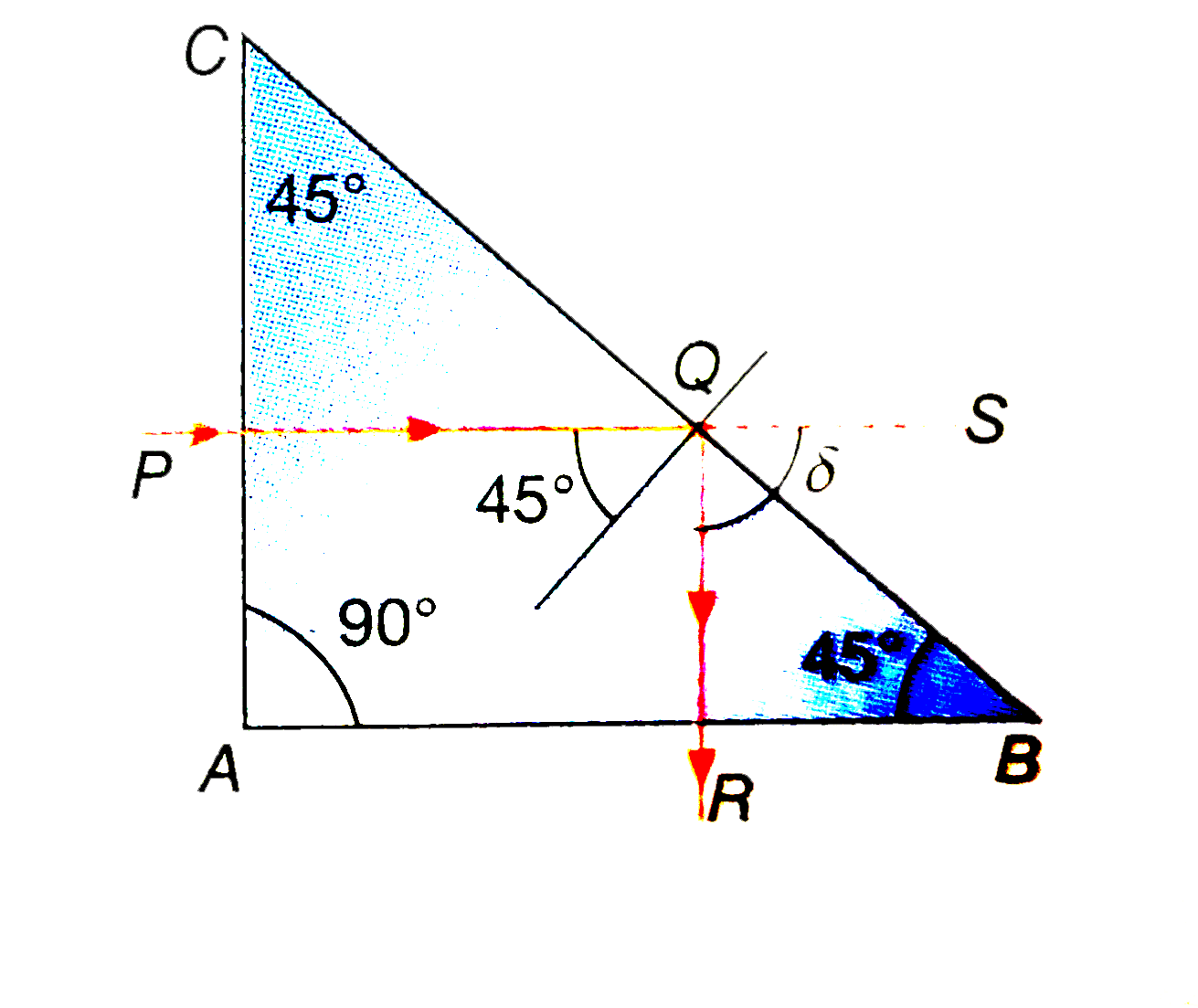A ray of light falls normally on one side other than the hypotenuse of a right angled isosceles prism of refractive index 1.5. From which side will the ray emerge from the prism? Find the deviation of the incident ray. Solution in Bengali
ABC is a right angled isosceles triangle [Fig. 2.69].
Angle of prism A=90∘
∴ ∠ABC=∠ACB=45∘
The ray of light is incident normally on the side AC and is incident on the side BC at an angle 45d∘ . As a result, after total internal reflection, the ray passes along QR perpendicular to the side AB.
Now, the angle of deviation =∠SQR=δ=90∘

Topper's Solved these Questions
- BOOK - CHHAYA PUBLICATIONCHAPTER - REFRACTION OF LIGHTEXERCISE - HIGHER ORDER THINKING SKILL (HOTS QUESTION)25videos
REFRACTION OF LIGHT
- BOOK - CHHAYA PUBLICATIONCHAPTER - REFRACTION OF LIGHTEXERCISE - SECTION RELATED QUESTION18videos
REFRACTION OF LIGHT
- BOOK - CHHAYA PUBLICATIONCHAPTER - REFLECTION OF LIGHTEXERCISE - INTEGER ANSWER TYPE3videos
REFLECTION OF LIGHT
- BOOK - CHHAYA PUBLICATIONCHAPTER - SEMICONDUCTORS AND ELECTRONICS EXERCISE - CBSE SCANNER31videos
SEMICONDUCTORS AND ELECTRONICS
Similar Questions
Monochromatic rays of light coming from vacuum are refracted in a medium of refractive index μ . Show that the ratio of the wavelength of the incident ray that of the refracted ray is equal to the refractive index of the medium.
01:48View SolutionWhat is meant by refraction of light?
03:42View SolutionThe image of an object placed at a distance of 40 cm from a convex mirror is formed at a distance of 10 cm from the mirror. If object approaches the mirror with a velocity of 32cm⋅s−1 , what will be the velocity of the image (incm⋅s−1)
04:43View Solution(a) Describe briefly with the help of a diagram the role of the two important processes involved in the formation of a p-n junction.
04:43View SolutionLight rays from a source are incident on a glass prism of index of refraction μ and angle of prism α At near normal incidence, the angle of deviation of the emerging rays is
02:11View SolutionIf a light ray incidents normally on one of the faces of the prism of refractive index 2 and the emergent ray just grazes the second face of the prism, then the angle of deviation is
View SolutionA monochromatic ray of light is incident normally on one of the refracting surfaces of a prism . The emergent ray grazes the second refracting surface . What is the angle of the prism if the refractive index of the material of the prism is 1.6 ?
View SolutionA monochromatic ray of light is incident normally on one of the refracting surfaces of a prism . The emergent ray grazes the second refracting surface . What is the angle of the prism if the refractive index of the material of the prism is 1.6 ?
View SolutionA ray of light is incident normally on one face of a right-angled isosceles prism and then it grazes the hypotenuse. The refractive index of the material of the prism is
03:42View SolutionA ray of light is incident normally on one face of a right angled isosceles prism. It then grazes the hypotenuse. The refractive index of the material of the prism is
View SolutionA light of ray incidents normally on one side of equilateral prism. If refractive index of prism is 1.5, then deviation angle is ......
03:50View SolutionIf a light ray incidents normally an one of the faces of the prism of refractive index 2 and emergent ray just grazes the second face of the prism, then the angle of deviation is
View SolutionA ray of light is incident normally on one face of a prism of refracting angle A. After travelling through prism, the ray emerges from the second refracting surface making an angle of deviation of δ. The refractive index of the material of prism is
02:40View SolutionIf a light ray incidents normally on one of the faces of the prism of refractive index '2' and emergent ray just grazes the second face of the prism, then the angle of deviation is
View SolutionThe refractive angle of prism is A. A ray is incident normally on one of the refracting faces of a prism and emerges out. If D be the deviation of the ray then refractive index of the material of the prism is—
View Solution

